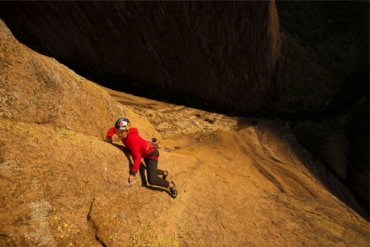If there’s a singular job that epitomizes working in the outdoors, it’s the mountain guide. We talked with IFMGA-certified guide Kris Erickson for insight into an undeniably epic career.

HE CLIMBS, SKIS, AND GUIDES up to 150 days each year in mountain ranges around the globe. But Kris Erickson, a Montana native, did not land an epic job out of anywhere. Like any field, he trained, studied, traveled, and learned over years — then decades — to reach the top of his profession.
Erickson is a member of an elite group. He is one of just more than 100 guides in the U.S. who have certification from the International Federation of Mountain Guide Associations (IFMGA). The designation signifies advanced proficiency in the three pillar disciplines — alpine, rock, and ski — and can take years to obtain.
Indeed, after twenty years of guiding, Erickson went back to school to gain the IFMGA credentials. Securing the certification can take five years and thousands of dollars in courses, travel, and training.
IFMGA Mountain Guide: What It Takes

Clients think of mountain guides as physically fit and technically sound climbers with lots of experience in the local area. Erickson believes that falls short of the true professional approach to guiding.
“A lot of guides who haven’t had structured training get into a habit of what I call ‘faith-based’ guiding. They think they are doing things right, but honestly, they are very poorly versed in what it means to constantly provide security for their guests,” he said.
“As an IFMGA guide, you learn to do that like a Jedi knight. You are always moving three or four steps ahead of people so you constantly have that sense of safety.”
Erickson said fitness and technical skill is just the beginning; learning to apply those skills with security that benefits the client “is why they are paying you.”
IFMGA Certification: A ‘PhD’ In Mountaineering
Jane Anderson, a guide program manager at the American Mountain Guides Association, explained: “The certification process is challenging and takes dedication and commitment. The IFMGA certification process through the AMGA includes seven courses and three exams.”
This amounts to 90 days in the field on AMGA courses and exams. However, it takes many additional days of training, guiding, and personal climbing and skiing in order to gain the experience necessary to be ready for each AMGA program.
In the United States, becoming a mountain guide can be as easy as getting a permit to work on a specific piece of public land and hanging a “hire me to be your guide” shingle.

“There isn’t the same connection with identifying what it means to be a professional mountain guide [in the United States],” Erickson said. “In Europe, it’s a protected professional like being a doctor or lawyer — if you want to work as a guide in Europe, you can’t call yourself a mountain guide without having that license.”
Clients recognize the profession and understand you spent years training, Erickson noted. “They are willing to pay for those skills.”
Client and Guide: The Relationship
Erickson has guided around the world, from high Himalayan peaks to rock climbs in America. He works as a ski-mountaineer guide, which is the most challenging facet. “People assume alpine or rock climbing is more difficult or dangerous than ski guiding. For me, ski guiding is the most dangerous.”
In alpine and rock guiding, he explained, you are always roped to your client and have control over them. You can instruct them how you want them to move. Their safety is within a closed system. With skiers, you have to rely on communication skills to convey the seriousness of the situation.
“It’s kind of a dark art in some ways. The ski-mountaineering guiding is far more difficult and challenging because you need to be several steps ahead analyzing the client’s ability and how they will execute your explicit instructions when they aren’t secured to you by a rope.”
After decades of personal accomplishments and guiding responsibilities, Erickson still feels satisfaction when a client achieves their goal.
“When you see someone grow through the process of learning new skills, finding the excitement and the enjoyment that comes with things they had no idea they were going to learn… that is very rewarding. Those are the clients who you want to spend time with and watch them excel.”
Looking for a job like this? Our new site highlights some of the toughest, most extreme (and best) jobs on Earth.
–Epic Occupations content is sponsored and presented in collaboration with YETI.







